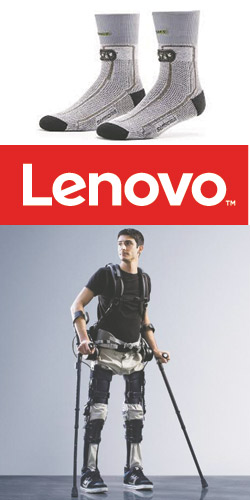
By Gary M. Kaye
Chief Content Officer, Tech50+
www.tech50plus.com
One of the hottest topics at the recently concluded M-Enabling Summit outside Washington D. C. was wearables – great new technology that one way or another attaches to our bodies. The Summit focuses on new technologies to help elders and the disabled, but it also covers mainstream devices. In the decade since the advent of wrist-worn activity trackers, tens of millions have been sold. Yet according to research done for Philips, roughly 77 percent of devices go unused within six months. Still, activity trackers represent the first wave as part of the “quantified self” movement tracking how we walk, sleep, stand, run, and eat.
Beyond steps and sleep
The first wave of devices can also measure things like blood oxygen levels, heart rate, and blood pressure. That brings us to the second wave; devices that not only measure but also diagnose conditions. Examples: Dexcom makes a continuous blood glucose monitor that uses tiny probes that barely penetrate the skin, unlike traditional glucometers that require a drop of blood. AliveCor’s Kardia device teams up with your smartphone or smartwatch to measure and diagnose heart irregularities. An implantable monitor the size of a paper clip from Medtronics can be inserted into the heart with a minimally invasive procedure and will report on any irregularities.
Those clothes do what?
New fabrics embedded with sensors from companies like Sensoria and BeBop are also promising, allowing measurement and diagnostics without inconvenience. Example: a shirt that measures heart rate and respiration, or socks that measure gait and sense the kind of pressure that can cause diabetic foot ulcers. Sensoria is partnering with Orthotics Holding Inc. on a device that can predict a likely fall. A personal emergency response system from Philips, the GoSafe, can help predict if a near term event may occur such as a stroke that will require emergency transportation.
Health ‘enhancements’
Beyond devices that quantify and diagnose are perhaps the most exciting wearables, those that are therapeutic. In some cases there are new technologies coupled with old solutions. For example, eyeglasses are therapeutic, as are hearing aids. But new vision enhancement devices from OrCam will allow someone with low vision to “read” menus, signs, book, and even recognize faces with a combination of optical character recognition, machine vision, and artificial intelligence and provide information in your ears. New hearing aids from GNResound and Singia will allow you to answer calls from your smartphone, or even get a direct input from microphones worn by actors in a Broadway show. These technologies don’t come cheap. The Orcam system costs between $2,500 and $3,500 and includes several hours of hands on one to one training. Top-end Food and Drug Administration-approved hearing aids require a fitting by an audiologist, run between $1,800 and $6,000, and generally aren’t covered by insurance.
High tech fabrics from companies like Opedix and EnerSkin can behave like compression wraps to help heal injuries and prevent weekend warriors from damaging untrained muscles. The logical extension of this comes in the form of an exoskeleton, like the ExoSuit, that will help a paraplegic to walk, and eventually could be something an elder slips into to get around or lift heavy objects.
But if you think what’s here now is impressive, as the folks say, “you ain’t seen nothing yet” The combination of 3D printing and stem cell research holds the promise of creating custom spare parts. A Brooklyn based company called EpiBone is already growing replacement bones, or parts of them, in the lab for wrists or ankles. Eventually scientists will be able to use these technologies to create kidneys, livers, even hearts, from our own cells, eliminating organ rejection. Many of these breakthroughs could be a decade to generations away. But devices already on the market can keep better track of our conditions and share that information with those who care for us, hopefully enabling us to live safer, longer, and healthier lives now.
Gary Kaye is the creator of Tech50+ (www.tech50plus.com), the leading website covering technology from the Baby Boomer perspective. Kaye has been covering high tech for more than 30 years with outlets including NBC, ABC, CNN and Fox Business. He is a regular contributor to AARP and other websites on issues regarding the nexus of technology, seniors and baby boomers.